Coastal killifish, etc.
Started by
Guest_Newt_*
, Jul 28 2009 03:43 PM
21 replies to this topic
#1
 Guest_Newt_*
Guest_Newt_*
Posted 28 July 2009 - 03:43 PM
I am thinking of setting up a brackish or saltwater tank with some killifish and gobies. I haven't seen too much info on coastal killies other than mummichogs. I'd particularly like info on temperament, as I want to know which I can keep in a community tank. At least to start I am looking at Outer Banks species, which as far as I can determine consist of Fundulus majalis, F. heteroclitus, F. diaphanus, Lucania parva, and Cyprinodon variegatus.
I would also appreciate any suggestions on other good community fish and shellfish which may be caught in the Outer Banks or Pamlico Sound. I will mainly be dipnetting and seining in wadeable water. I may also do a little fishing with hook and line.
As an aside, does anyone know where I can find the regulations for taking nongame fish in North Carolina coastal waters? The only regs I can find are size and bag limits for game fish.
I would also appreciate any suggestions on other good community fish and shellfish which may be caught in the Outer Banks or Pamlico Sound. I will mainly be dipnetting and seining in wadeable water. I may also do a little fishing with hook and line.
As an aside, does anyone know where I can find the regulations for taking nongame fish in North Carolina coastal waters? The only regs I can find are size and bag limits for game fish.
#2
 Guest_fundulus_*
Guest_fundulus_*
Posted 28 July 2009 - 05:02 PM
From your list I would recommend against both F. majalis and F. diaphanus for the type of tank you seem to want. The first is really a full saltwater fish who can tolerate regular exposure to brackish water, and is also very active and does best with open water available. The second is a freshwater fish with low tolerance for brackish water; you usually find them along the coast in freshwater ponds separated from saltwater by dunes.
#3
 Guest_Newt_*
Guest_Newt_*
Posted 28 July 2009 - 05:10 PM
Thanks Fundulus! Right now my plans for the tank setup are nebulous, and I haven't decided whether to go brackish or marine. If I did go marine, would F. majalis work well in a 75 gallon tank (48" X 18" footprint) or is that still too confining? Can they be kept with smaller fishes, such as sheepshead minnows and small gobies?
#5
 Guest_fundulus_*
Guest_fundulus_*
Posted 28 July 2009 - 06:22 PM
If you're going for a big marine tank that's probably good for majalis. They have fairly small mouths so they're not a big threat to other fishes, but like I said they're usually very active and in motion. They have a fairly predictable activity pattern along shorelines, coming in with the tide and foraging in ankle-deep water as waves break and wash out. This is usually the easiest time and place to net them, especially at creek and bay mouths.
#6
 Guest_fritz_*
Guest_fritz_*
Posted 29 July 2009 - 09:23 AM
[
As an aside, does anyone know where I can find the regulations for taking nongame fish in North Carolina coastal waters? The only regs I can find are size and bag limits for game fish.
[/quote]
If you take any kind of fish in NC coastal waters for recreational purposes with a dip net, seine, cast net etc, you will have to get a coastal recreational fishing license. A 10 day non-resident license is $10. Check out the website ncfisheries.net
As an aside, does anyone know where I can find the regulations for taking nongame fish in North Carolina coastal waters? The only regs I can find are size and bag limits for game fish.
[/quote]
If you take any kind of fish in NC coastal waters for recreational purposes with a dip net, seine, cast net etc, you will have to get a coastal recreational fishing license. A 10 day non-resident license is $10. Check out the website ncfisheries.net
#7
 Guest_Newt_*
Guest_Newt_*
Posted 29 July 2009 - 10:59 AM
Blake- I don't have a firm stock list in mind. I'm really not very familiar with marine and brackish fishes, so I don't have a good idea of who would work in this tank and who wouldn't. I go out to the OBX almost every year. Last time I was there I netted some small Fundulus sp., silversides, pinfish, and small squid in Silver Lake Harbor; mosquitofish, bay anchovies, pinfish, and at least two species of shrimp (Palaemonetes sp. and Penaeus sp.) in a salty "creek" (really just an inlet); and more Fundulus, Palaemonetes, hermit and fiddler crabs, a stingray, and a juvenile spadefish in a salt marsh. I found blue crabs at all sites.
Of those, I know the spadefish, blue crabs, and of course the stingray are too big and predatory for my tank, and the silversides are unlikely to survive capture and the long journey home. I'd be interested in keeping any and all of the rest, though, so long as they are compatible with the killifish. I would also like to try to capture some gobies, sleepers, and maybe even small flatfish, and investigate some more of the invertebrate fauna.
There are pipefishes and seahorses around the Outer Banks too, but I'm pretty sure I wouldn't be able to care for them properly even if I did catch any.
Fundulus- Thanks! Are mummichogs likely to be in the same place as F. majalis? When I've caught killies before it's been in the situation you described. Is there a good field character for separating juveniles of the two species? I wouldn't mind keeping both, I just want to be sure at least some of them are majalis.
Fritz- Thanks!
Of those, I know the spadefish, blue crabs, and of course the stingray are too big and predatory for my tank, and the silversides are unlikely to survive capture and the long journey home. I'd be interested in keeping any and all of the rest, though, so long as they are compatible with the killifish. I would also like to try to capture some gobies, sleepers, and maybe even small flatfish, and investigate some more of the invertebrate fauna.
There are pipefishes and seahorses around the Outer Banks too, but I'm pretty sure I wouldn't be able to care for them properly even if I did catch any.
Fundulus- Thanks! Are mummichogs likely to be in the same place as F. majalis? When I've caught killies before it's been in the situation you described. Is there a good field character for separating juveniles of the two species? I wouldn't mind keeping both, I just want to be sure at least some of them are majalis.
Fritz- Thanks!
#8
 Guest_fritz_*
Guest_fritz_*
Posted 29 July 2009 - 12:00 PM
In my experience the 2 killies usually don't occupy the same habitats. Striped killies tend to be out in the open away from vegetation over sand while mummichogs are usually very close or in the marsh. Juvenile mummichogs (and adults) have a dark spot on the back at the anterior base of the dorsal fin. Not sure if stripe killies do or not.
#9
 Guest_Dustin_*
Guest_Dustin_*
Posted 29 July 2009 - 12:55 PM
While I agree with Fritz's description of the two preferred habitats, we do catch them together in a few spots. I think another important distinction, which I think Bruce pointed out earlier, is that majalis is essentially a salt water fish and rarely goes very far upstream, while heteroclitus is not unusual in fresh water ponds with salt influence. These two are easy to tell apart, even as juvelies. Majalis has an overall silvery white base color with dark stripes or bars, even as small juvies and heteroclitus has an overall olive brown base color with lighter bars.
#11
 Guest_mikez_*
Guest_mikez_*
Posted 01 August 2009 - 06:13 PM
I can't say enough good about rainwaters. I've waxed verbose on the subject numerous times so here I'll just say - if you get any at all, keep them. No matter whether you go with brackish, salt or even for your freshwater tanks. Makes little difference to them. They breed and keep their color in anything wet.
You should definitely get into the sound side, around some creeks and maybe some emergent grass. Should find sheepshead, mummies, and rainwaters plus juvies of various marine species. Try to find a way to get way back in the marshes. The ones on Ocrakoke are awesome, as I believe we have discussed before.
The clean sandy current areas inside the inlets should have some of the above plus more marine species. That's where you'll get your flatfish. Watch for them to scoot ahead of you as you wade shallow sandy areas. Prolly length limit issues there though.
Hermit crabs make the best inverts besides ghost shrimp. Collect lots of extra snail shells to go with the hermits. Not many other good inverts in the sand and mud habitats. Go on the jetty rocks in the inlets for cool urchins, crabs etc. The big ghost crabs that run around on land on Okrakoke actually make cool captives in a ten gallon half filled with sand kept wet so they can burrow. Lots of personality.
Always take lots of pics and report here. I love it there and will enjoy a vicarious visit. Lots of cool herps to be found too.
You should definitely get into the sound side, around some creeks and maybe some emergent grass. Should find sheepshead, mummies, and rainwaters plus juvies of various marine species. Try to find a way to get way back in the marshes. The ones on Ocrakoke are awesome, as I believe we have discussed before.
The clean sandy current areas inside the inlets should have some of the above plus more marine species. That's where you'll get your flatfish. Watch for them to scoot ahead of you as you wade shallow sandy areas. Prolly length limit issues there though.
Hermit crabs make the best inverts besides ghost shrimp. Collect lots of extra snail shells to go with the hermits. Not many other good inverts in the sand and mud habitats. Go on the jetty rocks in the inlets for cool urchins, crabs etc. The big ghost crabs that run around on land on Okrakoke actually make cool captives in a ten gallon half filled with sand kept wet so they can burrow. Lots of personality.
Always take lots of pics and report here. I love it there and will enjoy a vicarious visit. Lots of cool herps to be found too.
#12
 Guest_Newt_*
Guest_Newt_*
Posted 02 August 2009 - 07:31 PM
Thanks Mike! I know a few saltmarsh access sites on Ocracoke, and I will certainly spend some time there. Last time I went I took a ton of pics, almost all of which came out rather poorly. I hope to take a new camera and a photo tank this time. It is looking increasingly likely that I'll have to wait until spring to go, which will give me time to save up for a nice camera and underwater case.
Have you tried keeping any saltwater molluscs? There are plenty of cockles, oysters, and little squids in the harbor at Ocracoke, which I think would be fantastic to keep (not necessarily in the same tank as the fish). I'd also like some snails, but have never found live ones there.
Some pics from last time (the last two are from a salt marsh, the rest from a creek, all on Ocracoke):
bay anchovy
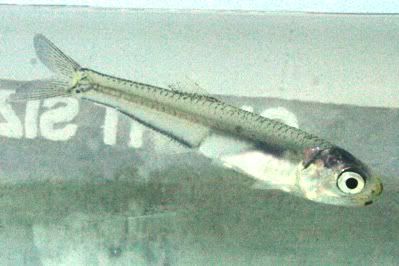
unidentified sciaenid (?)
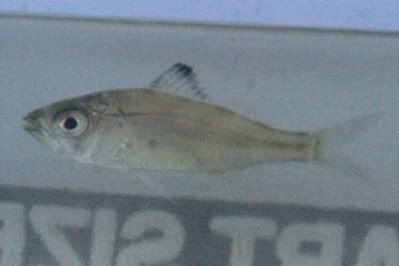
pinfish
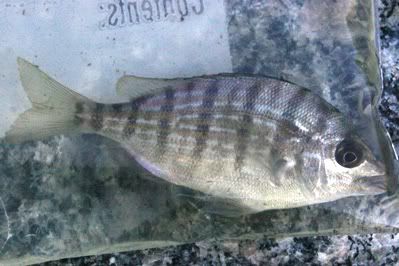
penaeid shrimp (these things were rocketing around the creek and taking 4-6 foot long leaps out of the water; I caught this one when it beached itself in the rushes)

diamondback terrapin with barnacles
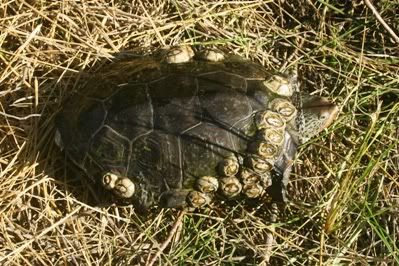
juvenile spadefish
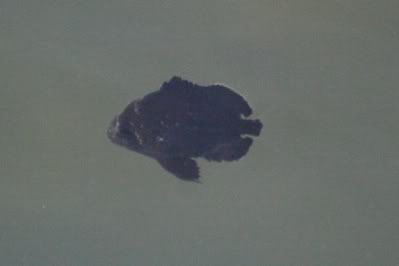
female fiddler
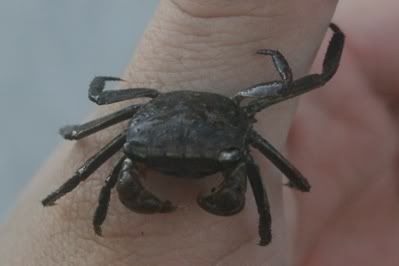
Have you tried keeping any saltwater molluscs? There are plenty of cockles, oysters, and little squids in the harbor at Ocracoke, which I think would be fantastic to keep (not necessarily in the same tank as the fish). I'd also like some snails, but have never found live ones there.
Some pics from last time (the last two are from a salt marsh, the rest from a creek, all on Ocracoke):
bay anchovy

unidentified sciaenid (?)

pinfish

penaeid shrimp (these things were rocketing around the creek and taking 4-6 foot long leaps out of the water; I caught this one when it beached itself in the rushes)

diamondback terrapin with barnacles

juvenile spadefish

female fiddler

Edited by Newt, 02 August 2009 - 07:32 PM.
#15
 Guest_mikez_*
Guest_mikez_*
Posted 03 August 2009 - 07:24 PM
I've kept loads of hermit crabs. They make good clean up crew and are fun to watch.
I've kept urchins and starfish with success and loads of crabs, mostly from hitchhikers. Various mollusks have also turned up as hitchhikers as well. I don't have enough motivation to go the extra mile to give them conditions they need. Generally inverts are harder than fish. They make good indicators though. When the inverts start dropping, time to do a water change.
As I know you already know, there is a whole big world of cool inverts out there. Best advice is get you a snorkel and mask and dive in. Dock and bridge pilings are great, any rock piles too. The jetties at the inlets are closest thing to a reef anywhere nearby. Best variety of both fish and inverts, with tropicals in the mix after late summer. Only problem is, it's kinda like combat swimming, fighting current and swells and dodging boats and the harbor master. Generally frowned upon.
Up here the harbor master goes home after Labor Day. The current and surge and boats just add to the fun. Not for everybody though and some real danger above and beyond normal fish collecting conditions.
I've kept urchins and starfish with success and loads of crabs, mostly from hitchhikers. Various mollusks have also turned up as hitchhikers as well. I don't have enough motivation to go the extra mile to give them conditions they need. Generally inverts are harder than fish. They make good indicators though. When the inverts start dropping, time to do a water change.
As I know you already know, there is a whole big world of cool inverts out there. Best advice is get you a snorkel and mask and dive in. Dock and bridge pilings are great, any rock piles too. The jetties at the inlets are closest thing to a reef anywhere nearby. Best variety of both fish and inverts, with tropicals in the mix after late summer. Only problem is, it's kinda like combat swimming, fighting current and swells and dodging boats and the harbor master. Generally frowned upon.
Up here the harbor master goes home after Labor Day. The current and surge and boats just add to the fun. Not for everybody though and some real danger above and beyond normal fish collecting conditions.
Reply to this topic
1 user(s) are reading this topic
0 members, 1 guests, 0 anonymous users







